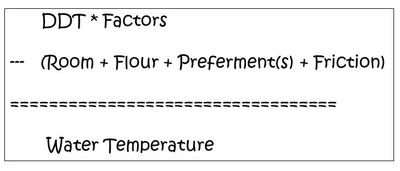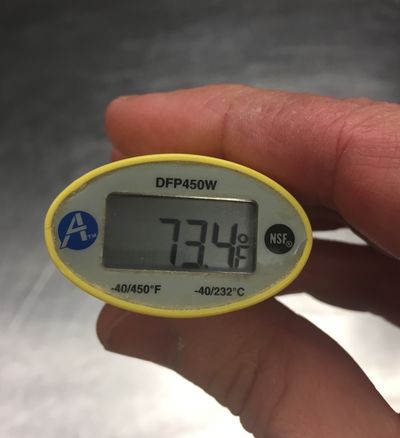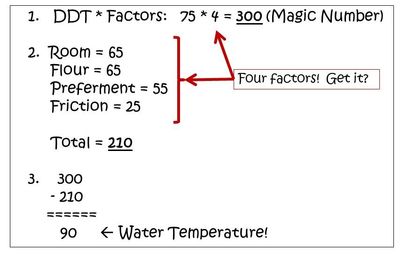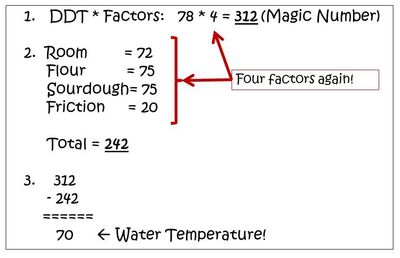Whether you're reading a good bread baking book or going through the Learning Loaf course, I'm sure you've noticed a lot of references to dough temperature. Depending on the author, they are shooting for a temperature of between 75F and 82F (24C and 28C) when the dough is finished mixing.
So how important is dough temperature, really? The short answer: VERY IMPORTANT!
I can't really think of anything that is easier to control and which pays the biggest dividends to get right. Hit your dough temperature and you can relax and focus on the rest of the baking process in a controlled manner. Miss your temps and you'll be stressing through the rest of the bake.
Why Dough Temperature Matters #
Dough Temperature = Time. It's that simple really. Keep your dough in the correct temperature zone and the yeast (or sourdough culture) in the dough can feed at the optimal rate. Fermentation is predictable and your bake day is predictable.
When your dough is too cold, the yeast slows right down. A bulk fermentation step that should take 1.5 hours can take 3 or even 4 hours.
When your dough is too warm, fermentation accelerates. The enzymes in the flour don't have enough time to break down the starch in the flour, so your loaf won't taste as awesome as you'd like. And if you don't recognize the issue, your dough will be over fermented when you try to shape it, causing challenges at that stage too.
The problem magnifies if you're trying to bake several batches of dough at a time, whether in a bakery or in your home oven. Inconsistent dough temperatures will wreck your day. The oven sits empty while you wait for a cold dough to finish proofing, then two batches are ready to bake at the same time. Not good.
How To Get Your Dough Temperature Right Every Time #
The good news is that it's relatively easy to nail your dough temperatures every time. All you need is three things: a thermometer, a formula and some arithmetic.
Thermometer #
If you bake with yeast, it's well worth getting a good digital probe thermometer. A good one will cost you around $30 and is worth it. Wholesale club, Costco and restaurant supply stores all carry them, or you can go online too.
Make sure the thermometer you buy has a digital readout (for accuracy) and is waterproof (because you will drop it in water, guaranteed.) And if the range goes above 400F, you can use your new tool for other things like taking internal temperatures for meat and bread, or making sure your fry oil is the right temperature for doughnuts.

My favourite dough thermometer. Couldn't live without it.
The Dough Temperature Formula #
There are four or five things that affect dough temperature:
- Room temperature
- Flour temperature
- Preferment/starter/soaker temperature(s)
- Mixing Friction (Your dough temperature will rise through the effort of mixing.)
- Water temperature
You don't have much control of the first four items on that list. But you usually have control of your water temperature. So our Dough Temperature Formula will calculate the desired water temperature based on the temperature of the other items.
Here's the formula:

[DesiredDoughTemp * #OfFactors] - [RoomTemp+FlourTemp+PrefermentTemps+FrictionTemp] = WaterTemp
Trust me, it's easier than it looks. Let's break it down.
DesiredDoughTemp: What you want your final dough temperature to be. I use 75F for dough with commercial yeast and 78F for sourdoughs. Using both? Go with 78F then.
#OfFactors: How many variables other than water do you have? At minimum, this is 3 (room, flour, friction).
Using a preferment? That's 4. Preferment and a soaker? That's 5.
RoomTemp: Room temperature. I keep my thermometer near my mixing bench and use the temperature right after I turn it on. But maybe you have a thermometer on the wall.

Taking the room temperature. Make sure you're not touching the probe, or you're measuring body temperature!
FlourTemp: Temperature of your flour, of course! I just plop my thermometer right into the middle of the flour after it's scaled out and take the temperature.
PrefermentTemp: Same as the flour; just take a temperature right in the middle of your preferment and/or soaker.
Friction: This is something that you'll learn over time, based on trial and error. I start with a friction factor of 25F when I'm testing a new mixer or new technique. If my dough is cool, I'll use a lower friction factor next time. Too hot means I'll raise the friction factor.
The Arithmetic #
Here's what I do:
- Multiply DDT * #OfFactors. I call that my "magic number" and I usually have it memorized. (But I'm like that. Calculate it every time if you need to!)
- Take my ingredient temperatures and add them up.
- Subtract the temps from the magic number to get the water temperature.
I try to get the water temperature within 1-2 degrees of my target.
Once I mix the dough, I take the temperature of the dough to see how I did. If I'm way off, I'll adjust friction next time.
An Example: #
Let's say I'm mixing a Crusty White Loaf in my basement mixing room in winter. It's a yeasted loaf with a prefermented dough. Here's what I know:
DDT: 75F
#OfFactors: 4 (room, flour, preferment, friction)
Steps:
- My magic number is DDT * Factors = 75 * 4 = 300
- I take all my ingredient temps a) Room = 65F (blissfully cool!) b) Flour = 65F (it's been sitting in the mixing room for a week now so that makes sense) c) Preferment = 55F (I had it in the fridge and it's still warming up) d) Friction = 25F (I expect the temp to rise 25F through the effort of mixing.)
- Add them all up. 65 + 65 + 55 + 25 = 210
- Subtract! 300 - 210 = 90

So my water temperature is 90F. If I use 90F water I can expect my dough temperature to be right around 75F after mixing.
Another Example #
This time, I'm going to mix my Country Sourdough, but at the bakery in summer. It's much warmer at the bakery than in my basement at home. How does that affect things?
DDT: 78F (Sourdough cultures like it warmer)
Factors: 4
- Magic Number = 78 * 4 = 312
- Ingredient Temps: a) Room: 72F (it's early morning - not too hot yet!) b) Flour: 75F c) Sourdough Culture: 75F (I mixed it warmer last night but it's cooled off) d) Friction: 20F (friction factor for my big spiral mixer)
- Add them up: 72 + 75 + 75 + 20 = 242
- Subtract! Water Temp = 312 - 242 = 70F

So if I use 70F water, I can expect my dough temperature to be 78F, right where I want it.
Hopefully through these two examples, you can see that you can't trust a recipe that simply says "use tepid water." There are too many assumptions in that instruction!
Over the course of a year, we would routinely use 90F water in winter, when everything was cold in the shop and then have to keep water in the cooler overnight to get 55F water in the summer time. Even tap water wasn't cold enough in summer.
Help! My Dough Temperature Is Off #
So even though you've followed all the steps, your dough temperature is off. What do you do?
First, don't panic. You need to adjust a few things, but all will be fine. The good news is you KNOW you have a challenge, right at the start!
If your dough is too cool, think warm thoughts. Put the mixing bowl in the oven with the light on. Wrap it up with blankets and put it in the warmest room in the house. Adjust your schedule to account for a longer fermentation period - maybe double your expected time or even more.
During the proofing phase, make sure the loaves proof in a warm, draft free area. Keep as much warmth around the loaves as possible.
The #1 thing with cool dough is to be patient. Things are going to take a while, so don't rush it. Make sure your dough is properly fermented before dividing and shaping.
If your dough is too warm, get ready! Things are going to move a little quicker than normal. Place the dough in a cool area and hope for the best
If your dough is way out of the zone (90F or more) you can pop the dough in the fridge, but be careful. With large batches, the outer parts of your dough will cool off but the centre will be warm for a long time. And with small batches, be sure it doesn't cool off too much!
Bottom line is if you have a temperature issue, stay on top of things. Take a temperature from time to time to see where your dough is at. Especially with small batches, the dough can get cold or warm quickly, so you may have to move more than once.
No matter what, if your dough temperature is off, consider why it happened. Was it a simple miscalculation? (It happens to all of us.) Or does your friction factor need adjusting next time?
Final Thoughts: Happy Yeast Is Happy Bread #
Whew! You made it to the end. Good for you.
Dough temperature is one of two bits of arithmetic (the other is baker's percentages) that turn many an eager bread baker into grumpy, bitter cake bakers. Or, heaven forbid, cooks.
Hang in there, baker friend. You can do this. Remember, you're doing all this number crunching to keep your yeast happy. Happily eating sugar and making CO2 and raising your bread. Help them out.
Bakers are craftspeople and artists. Scientists and stewards. Stewards of yeast. Happy Yeast = Happy Bread = Happy Bakers.
Do a little bit of work with a pencil and a calculator and the yeast will do the rest of the work for you. At least until it's time to divide and shape.
You deserve a sip of coffee during the bulk fermentation stage, instead of running around looking for a cool or warm place for your off kilter dough. So do the math and enjoy the brew.